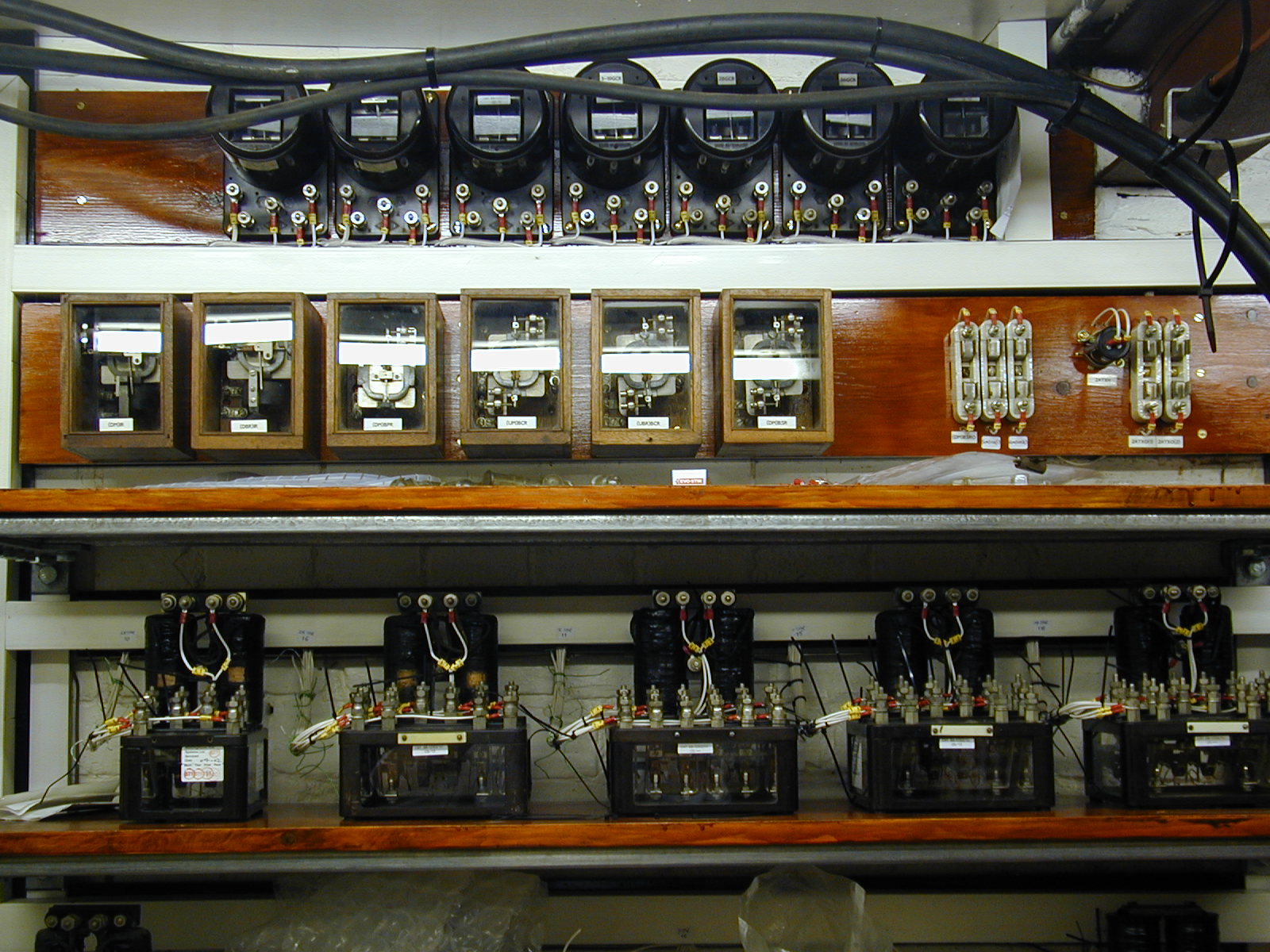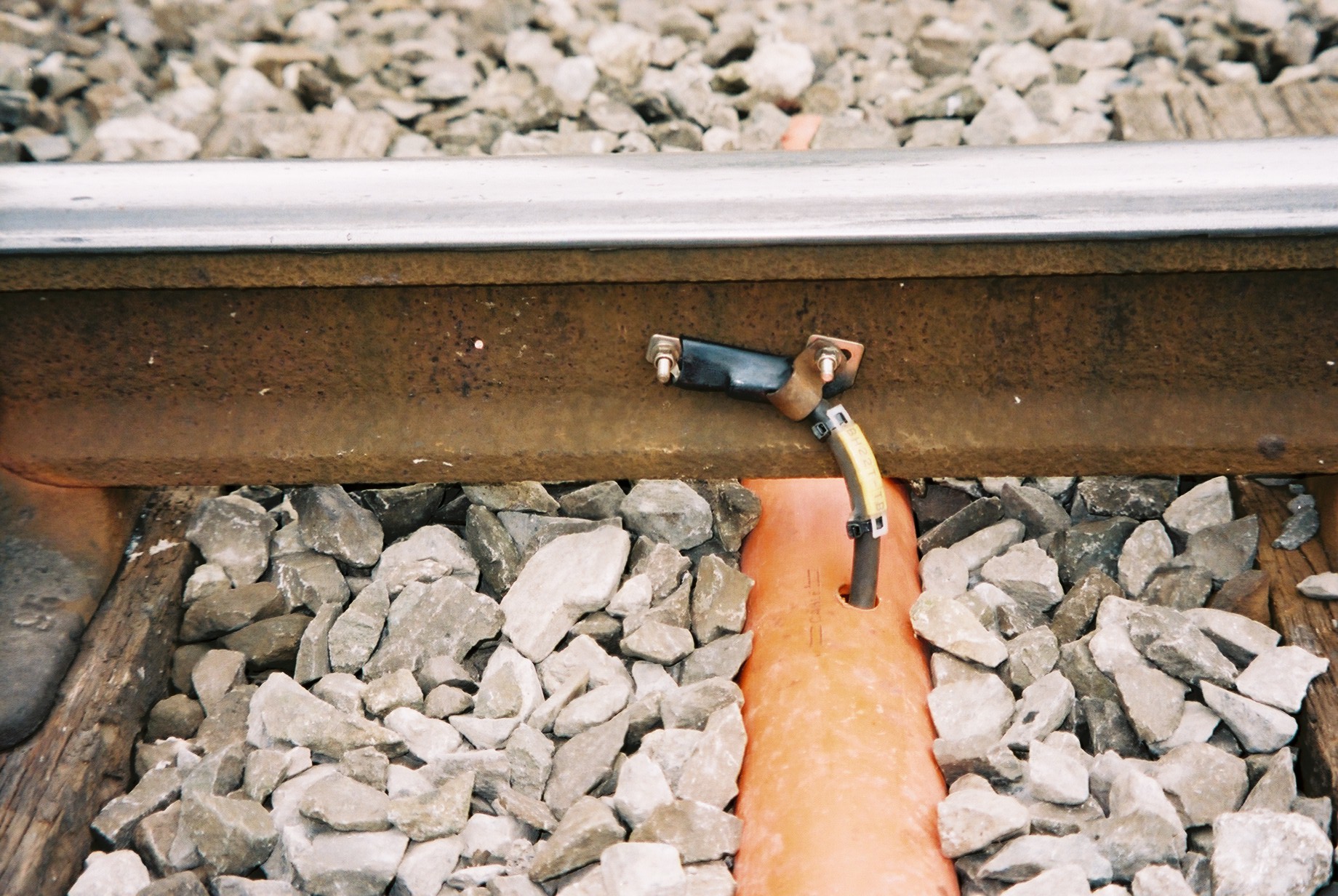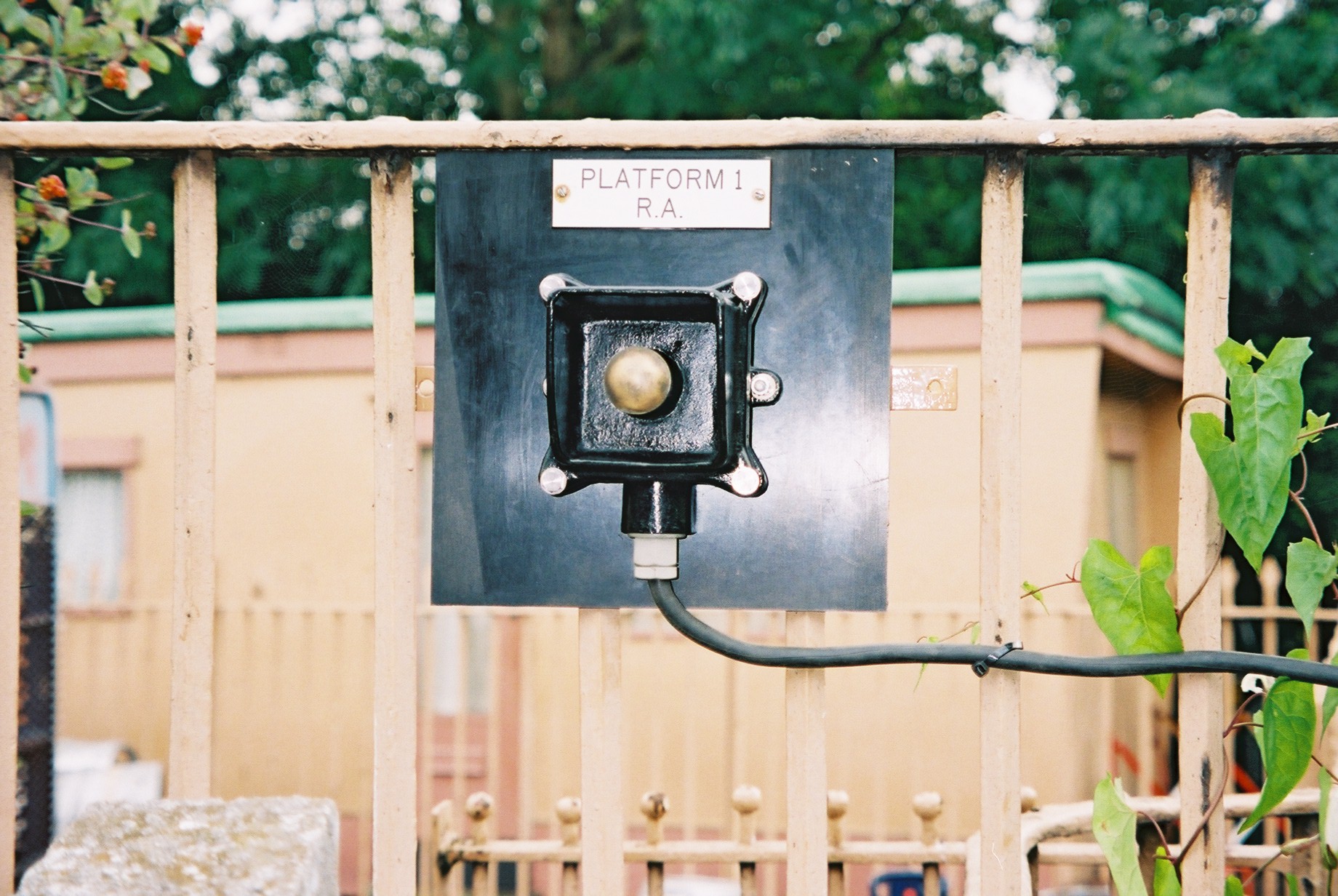 SVR S&T Dept.
SVR S&T Dept.


The first three shelves of relays near completion under North box - these are not yet in service and there are some signs of the 'work in progress' on the shelves below.
SIGNALLING NOTES - Chris. Hall
My conscience is telling me that several issues of the magazine have appeared since I last went into print so it is about time that another article should appear. Another year has passed and July is drawing to an end. Work 'behind the scenes' at North box has finished, about which more later.The annual S&T working week has just taken place (July 2005), starting with a pleasant Sunday Luncheon on the Venturer - twenty three of us enjoying a ride on the cushions with a delicious lunch, finishing as we were shunted conveniently across to platform 1 and the Railwaymans Arms. We dispersed as the last up train beckoned. A late night curry was not without some casualties and track circuit testing at Bewdley South the next day was initially concentrated on the immediate environs of the station with facilities close at hand. Denvir Drury and Richard Heap completed this testing and replaced some B50 fuse bases by the Down Distant (with only a slight delay to the light engine). Unlike last year, the fuses themselves remained intact.
Dave did the location cupboard maintenance from Bewdley North to Northwood - without getting stung by wasps - thus breaking a tradition of a few years. The major work was however at Arley where John Phillips, John Taylor, Dave Carr, Steve Growcott and Derek Jones assisted Adrian Hassell to plant the new location cupboard he had built for the Up Distant at Arley. The cupboard was delivered to site using the class 08 shunter before the start of service, taking refuge in Arley yard between trains, the box being switched out at the time. The work involved much digging for the posts to support the new cupboard and legions of wasps were kept at bay, initially with a length of trunking lid, then with a tin of burning grass, until despatched more effectively with a spray.
At Arley the new cables were cut to length and terminated in the afternoon. Meanwhile the 'Right Away' plunger on the platform at Bridgnorth was replaced by an outside type by Tony Neath and John Smith and contractors who had completed the external painting of North box surveyed Bridgnorth in preparation for similar work there. An evening meal at the Running Horse rounded off the evening nicely, although it was clearly only running at a canter or even at a trot as the food took an hour to arrive.
On the Tuesday, myself and another replaced three track circuit connections at Bridgnorth, carrying the orange pipe and rail drill to site in order not to overload Taw Valley - Driver and Fireman being confident of the engine's ability to do this, but the Fitter was not and over-ruled them. Recognising that it was only a Southern engine, we did not want to over tax it! Once the three track circuit ends at the Down Home had been replaced, using 'L' shaped plates to replace soldered connections onto copper 'D's, we started working through the track circuit testing.
Good progress was being made at Arley - the power supplies were wired up, the
new location cupboard was painted, using a bright shade of aluminium, generously
applied by Richard to those nearby, the grass and a signal post, as well as the
cupboard. The new cable, which had been laid out and buried the previous year,
was terminated with only two inches to spare following the episode of the strangely
moving cable reported in issue 146. The location was ready for testing by the end
of the second day.
Kevin Simpson was painting signals at Highley on the Tuesday and work at North box
was progressing rapidly through the morning, the old cable frame being removed by
lunchtime. all by now complete (other than completing the telephone recording
circuits). This means that the only obstacles to getting North box Distants
working is a length of power cable between Up Home and Down Starter and replacing
the refurbished five foot arms on the bracket outside South box. Some of the
afternoon was occupied in additional testing to prove the new circuits were
operating satisfactorily and the final gremlin was chased and caught (by 7 p.m.)
allowing us to adjourn to a pub in Bewdley.
The points leading to the Stourport line siding at Bewdley South had been
reinstated following some P-Way work and Tony Neath and John Smith had refitted
the detection and extension piece to the 'B' end of 10 points and adjusted and
tested the detection - this is the device that proves that the point blades have
operated correctly before the signal can be cleared - allowing the relevant signals
to be booked back on.
On the Wednesday a major tidying exercise at Bewdley North saw the old cable frame
and relay cupboards removed and dismantled but the focus of work was at Arley where
testing and commissioning of the new location cupboard was conducted by Fred
Cotterell with Richard Heap as asssistant. All signalling circuits were thus
removed from the overhead wires from the Up Home signal northwards, leaving just
the pole route on the Down side still in service. Martin Crane washed a number
of signal arms - I am hoping to persuade Martin to write a few words about his
unsung activities obtaining refurbished signal arms and other components.
Denvir and myself completed track circuit testing at Bridgnorth and
decided to move to Hampton Loade to join another member of the Department (who
shall remain nameless) to help with the routine maintenance and testing. Dave
had left as work commitments beckoned and on arrival at Hampton Loade we
were surprised to find cranks and compensators bearing fresh signs of (copious)
oiling but also daubed with the fiendish TrackLube, normally reserved for slide
chairs (and clothing). To appreciare the full horror of this development, a
description of this material is probably needed and Dave has kindly provided
this:
During the Autumn of 2004 a significant development occurred in
the field of point slide-chair lubrication. Over ten years ago the old sump oil
traditionally used for this task since the early days of the SVR was superseded
by a commercial product called TrackLube. This was a type of low-viscosity black
grease which, the manufacturers told us, would be much less easily removed by
rainwater or open steam cylinder cocks than the dirty oil it would replace; all
one had to do was to apply the stuff about once a month using a long-handled
brush and then forget about it. Easy, they said.
This was a cruel
piece of salesmanship„, as the manufacturers somehow neglected to tell us
that this was a malevolent product, possessed of a magical affinity to clothing
and unprotected skin. In the early days S&T staff were blissfully unaware
that just walking past an open container of the stuff was enough to provoke it
into leaping out at you when your back was turned, which resulted in a string
of unsuspecting victims wondering how and where they had become plastered with
assorted greasy black stains. We then discovered that, true to the advertising
blurb, it was indeed much less easily removed than the dirty oil it replaced -
in fact it was completely impervious to any cleaning product or technique known
to man. Once on the skin it would be several days before the last traces of
black could be removed, particularly embarrassing if you had inadvertently
rubbed one or both eyes and looked like Chi„-Chi„ the panda as a result.
Getting it on clothing was equally bad news; the dry-cleaners said that they'd
never come across anything like it and you could forget Danny Baker and the Daz
Doorstep Challenge — just one look and they would have quietly given up
and gone home. Of course, this meant that the application of Track Lube quickly
became one of the less pop„ular S&T duties as those performing it
invariably came back looking as though they had been to a dress rehearsal
of the Black and White Minstrel Show. A variety of excuses, some more believable
than others, were quickly proffered whenever it was mentioned that this job needed
doing somewhere up or down the line.
But progress marches on, and the
sticky black gunge has now been replaced by a new, superior product — an
even stickier white gunge. This has meant an extensive re-training programme for
S&T personnel to cope with the aftermath of the change. Early indications
are that the new stuff is even more weather-resistant than the old, which means
less frequent applications and a resultant saving in both costs and S&T time.
Much more importantly, empirical testing has already proved that it can be washed
off leaving no discernable trace on the skin and only a light stain on clothing,
a vast improvement on the old stuff!
Being out and about on the lineside
really does bring home how much busier the SVR is than in years past. A weekend's
routine maintenance at Kidderminster late in November, a time when the SVR used
not to run trains at all, was continually interrupted by service trains, freight
movements, light-engines and shunting in the carriage shed. All of this impacts
just as much on the engineering departments as it does on the operating ones, as
wear and tear on equipment is proportional to the number of times it is used,
rather than the amount of time it is available for use.
Aftr some interrogation at Hampton Loade, it became clear that the practice of
'daubing TrackLube' to 'preserve the oiled surfaces' had been advocated by
someone whose name could not be recalled. The mysterious appearance of
TrackLube to the wrong specification (for application to fishplates by the P-Way)
at each box has not helped. The mistaken advice had clearly spread to one or two
less well-informed members of the Department and is being ruthlessly eradicated.
Though entirely appropriate for point slide chairs, TrackLube simply attracts ash
and dust when daubed on cranks, compensators and FPL bolts and requires careful
cleaning and scraping to remove it before the next coat of oil can usefully be
applied. Waste engine oil is equally inappropriate and there is plently of
lubricating oil of the correct specification available.
There were fewer of us around on the Thursday and Denvir and Richard went
to Bridgnorth to complete replacement of some broken track circuit bonds
(we had been issued with only seven bonds initially, and these got used up
quickly on the Tuesday), a lift from the light engine being most welcome.
A survey of the Down Inner Home bracket at Bewdley South concluded that a
replacement main signal post would probably be necessary - rather than refit
the refurbished five foot signal arms this will now wait until the replacment
signal has been built. This will be a major piece of work, requiring a
temporary signal to be erected whilst the existing signal (featured nicely
in a photograph on the back cover of the last issue, albeit with temporary
signal arms for the Down Main) is removed and rebuilt.
On the Friday Richard, the youngest member of the Department, went to do
the routine maintenance at Highley - normally a one hour job - but found
not only cranks and compensators with what looked like a creosote stripe
but also the facing point plungers similarly treated with TrackLube. What
should have been an hour's job had thus turned into an all day job - on top
of the normal amount of work to apply oil, each item would have to be scraped
and cleaned first. The rest of us Denvir, Adrian and myself, spent the whole
day cutting down the trees obscuring the Up Distant at Arley, noting that the
wire run to the Distant was somewhat covered in bracken - another job that will
need doing very soon so that it is cleared away before it falls onto the wire
run as Autumn approaches (and will have been done by the time that you read
this).

The first three shelves of relays near completion under North box in August 2004.

One of the new track ends at Bridgnorth.

The new 'R.A.' plunger at Bridgnorth.